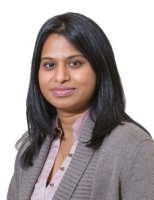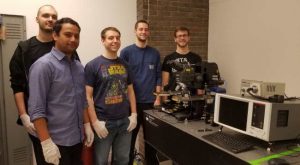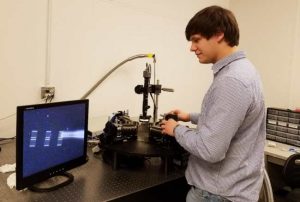R&D: Researcher at Cincinnati University Enable Massive Storage
With low power consumption and to perform more complex computing tasks
This is a Press Release edited by StorageNewsletter.com on October 25, 2017 at 2:25 pmFrom College of Engineering & Applied Science, University of Cincinnati
By: Ashley Duvelius
 Dr. Rashmi Jha, associate professor, Electrical Engineering and Computer Science, leads as PI on NSF-funded research that will enable massive data storage with reduced power consumption and increased complexity of computing tasks performed by a number of devices, ranging from smartphones, big data analytics, IoT, wearable electronics, assistive devices, cybersecurity to weather tracking systems.
Dr. Rashmi Jha, associate professor, Electrical Engineering and Computer Science, leads as PI on NSF-funded research that will enable massive data storage with reduced power consumption and increased complexity of computing tasks performed by a number of devices, ranging from smartphones, big data analytics, IoT, wearable electronics, assistive devices, cybersecurity to weather tracking systems.
With the rise of the cloud, artificial intelligence, and IoT (the foreseeable future in which not just humans but all our devices are connected to each other via the Internet), the need to store data has been forecasted to increase to ~163ZB by 2025. And in order to store such a vast amount of data, non-volatile memory (NVM) devices will be needed.
Consequently, by the year 2025, NVM will represent a $82.3 billion market.
Currently available conventional memory technologies face serious challenges in addressing these needs due to increased energy consumption, scalability limitations, and limited bandwidth.
Therefore, there is demand to develop new memory devices, circuits, and architectures to support these needs. Dr. Rashmi Jha, University of Cincinnati (UC) College of Engineering and Applied Science (CEAS) associate professor, Electrical Engineering and Computer Science, aims to develop new types of memory devices that will be massively scalable, energy-efficient, and fast which will open tremendous opportunities to integrate them in existing memory architectures to enable various futuristic applications.
Funded by the National Science Foundation (NSF), Dr. Jha’s UC group will collaborate with Dr. Swaroop Ghosh’s team at Penn State University to achieve the objectives of this research. Combined NSF-funding for UC and Penn State totals $450,000 and runs from August 1, 2017 through July 31, 2020 (estimated).
Jha explains: “Our latest and greatest technology advancements (such as AI, the IoT, machine learning, and deep neural networks) require massive data storage and in-memory computing, making new computer architectures like Tensor Processing Units (TPU) of the utmost necessity. Availability of on-chip memory and the ability to do in-memory computing will be critical to address the massive computer resources demands for training and inferencing using these architectures.“
When integrated with smartphones, Jha’s technology will allow the devices to not only store more data (i.e. pictures and videos) through low power consumption, but they will also be able to perform more complex computing tasks. Possible tasks include facial cues recognition, behavior recognition, and smart health monitoring with actionable insights. The integration of these systems in wearable computing platforms (wearable sensors, smart watch, smart-patch, smart-belt, smart-knee caps, point-of-care devices) will help programmers to implement more complex algorithms that can be used for applications such as monitoring rehabilitation after injuries, or skin cancer detections.
Dr. Jha’s PhD students in lab:
Andrew Rush, Abhijeet Barua, Joshua Mayersky, Thomas Schultz, and Alex Jones
Beyond handheld and wearable devices, the integration of this technology in data centers will greatly reduce their power consumption and enable data storage on a much larger scale.
She explains: “The types of memory devices we are developing will have tremendous opportunities in not only high density data storage but also developing computing platforms for advanced Artificial Intelligence. In the long-run, it would be highly beneficial for society if artificial intelligence in machines become as scalable and versatile as human brains. Then, for example, wearable robots will be able to help people suffering from Alzheimer’s disease to navigate and make decisions if they are lost, or help micro drones to make decisions like birds, or autonomous cars to have human-like intelligence.”
UC is leading this effort by providing excellent research facilities including ERC Microfabrication Center and Materials Characterization Center and the state-of-the-art Advanced Logic and Memory Devices Electrical Characterization facility at the Microelectronics and Integrated-systems with Neurocentric Devices (MIND) lab, under the direction of Jha.
Dr. Jha’s NSF REU student Tony Bailey making
measurements on synaptic memory devices in MIND lab.
Jha also plans to infuse her project with education by incorporating research outcomes into her academic courses. Undergraduate students will be involved in the research via Research Experiences for Undergraduates programs at Penn State University and University of Cincinnati.
Jha adds: “I hope to also involve under-represented groups in science and engineering through several outreach programs at both the universities, such as Summer Research Opportunities Program at PSU, and Emerging Ethnic Engineers (E3) program at UC. The E3 program provides opportunities to high-school students from the inner-city schools with economically challenged backgrounds to participate in internships and lab-experience activities.“
In addition to the NSF grant, Jha’s research group is collaborating with the Air Force Research Lab (both the Rome Research Lab in Rome, NY and the Wright-Patterson Air Force Base in Dayton, OH), and DAGSI (Dayton Area Graduate Studies Institute).
Jha joined the University of Cincinnati in 2015. She holds a PhD in Electrical Engineering from North Carolina State University (2006) and a Master of Science in Electrical Engineering also from North Carolina State University (2003). She attended the Indian Institute of Technology (IIT), where she earned her Bachelor of Science in Electrical Engineering in 2000. She received an NSF-CAREER award early on in her career to perform research in the areas of Neuromorphic Computing. Most recently, she was awarded Master Educator award by CEAS at UC.
She closes: “I would also like to thank all of my students and collaborators for their contributions on various projects. I work with a team of very talented undergraduate and graduate students and I’m excited to see what we accomplish together.”















 Subscribe to our free daily newsletter
Subscribe to our free daily newsletter

